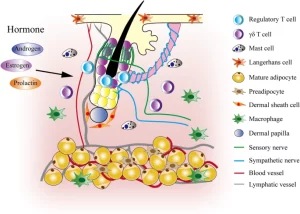In a recent paper, researchers have identified a potential target for treatment of alopecia, a autoimmune disorder whereby the immune system attacks the hair follicles resulting in hair loss (Figure 1). They were able to describe how regulatory T cells communicate via hormones and interact with skin cells, generating new hair follicles and promoting hair growth (READ MORE).

Figure 1: Hair follicle structure, hair follicle stem cell and hair cycle. Quiescent HFSCs reside in the bulge region and primed HFSCs are located in the secondary hair germ. They are transiently activated in early anagen, giving rise to progeny that grow down to form the lower portion of HFs. HFs progress through catagen (regressing phase), telogen (resting phase) and anagen (growing phase) cyclically. Matrix cells in the hair bulb actively proliferate and differentiate to support the continued elongation of the hair shaft in anagen. In catagen, the hair bulb shrinks and the lower portion of the HF regresses through a progressively shortened epithelial strand into the telogen HF. In telogen, HFSCs in the secondary hair germ and bulge remain inactivated (Chen, et al., 2020).
In this present study, the researchers investigated the function of regulatory T cells and the glucocorticoid receptors (GR) in skin tissue. They were able to describe the mechanism by which GR’s interact with T cells to activate hair follicle stem cells, this being done through the production of TGF-beta3 in regulatory T cells. In conventional treatments of alopecia, glucocorticoids are used to inhibit the immune reaction in the skin, these new insights have shown that this application can also trigger the production of TGF-beta3 which will result in hair follicle stem cell activation and subsequent hair growth.
In their own words:
“The present study identifies crosstalk between Treg cells and HFSCs mediated by the GR–TGF-β3 axis, highlighting a possible means of manipulating Treg cells to support tissue regeneration.”
Journal article: Liu, Z., et al., 2022. Glucocorticoid signaling and regulatory T cells cooperate to maintain the hair-follicle stem-cell niche. Nature Immunology.
Summary by Stefan Botha










